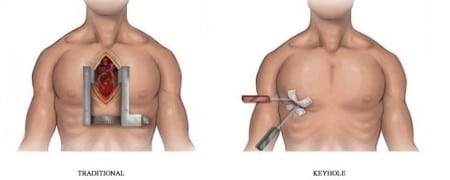

Sun 29 July 2018
In a recent small randomised trial published in the BMJ, 40 patients with severe aortic stenosis were randomised into minimally invasive (keyhole) versus full sternotomy (full breastbone division) surgery. Echo scans were used to look at the effectiveness of the right ventricle after the surgery and the findings were very interesting.
In the keyhole group, right ventricluar contraction was preserved but in the full sternotomy group, right ventricular contraction deteriorated compared to preoperatively. Although both groups showed a reduction in certain aspects of right ventricular function, this was more pronounced in the full sternotomy group.
Why should this be the case?
The authors suggest that full sternotomy is associated with full division of the pericardial sac within which the heart is located throughout life. This may result in a loss of support to the heart. In keyhole heart surgery, not only is the breastbone not fully divided (and in some cases not divided at all), the pericardium is left intact also. This may result in continued mechanical support for the heart from the intact pericardium.
Further study is required, but for now it would be safe to say that keyhole heart surgery in experienced hands may offer so much more than quicker healing and superior cosmetic results. We believe that keyhole heart surgery should be the default treatment strategy for all patients with severe aortic stenosis who require surgery.
